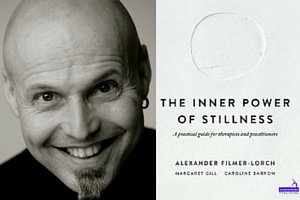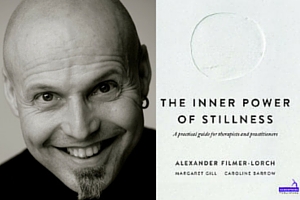Alexander Filmer-Lorch on the Inner Power of Stillness


In this month’s Symposium Spotlight, Alexander Filmer-Lorch joins us to talk about The Inner Power of Stillness, and how it impacts on our physiology, our emotions, our intellect….and on our work as therapists.
Your experience seems to cover so many areas – movement, meditation, Eastern philosophy – could you tell us where CranioSacral Threrapy fits in?
Well, at the time i moved to Brighton, I taught a lot of yoga and movement practices, because I was a dancer initially. I had always heard about CranioSacral therapy, and at a centre in Brighton someone introduced me to a lady called Maggie Gill. At the second session Maggie suggested to me ‘You should do this work’. I didn’t have a background in it and I couldn’t possibly imagine ever being able to do anything like this. So I kept having sessions, and then a year later I had this brown book in my hand [CranioSacral Therapy by Dr John Upledger & J D Vredevoogd] which was a gift from Maggie, and a little note saying when the next course dates were….
By that time I just felt that this work is so wonderful! You see a lot of things when you work with people, especially in a one-to-one sessions, whether in yoga or meditation. Certain things come up, sometimes people have a few tears, or they say they feel completely absorbed in some memories. And I thought it would be wonderful to really be able to respond in the appropriate way. I had studied Eastern psychology and philosophy in india over twelve years, and I did many courses in movement-related practices in between, but what was missing was that third element. I was able to facilitate people on a movement level. i was able to work with their inner world which related to their psychological body – but not on the tissue, which made the whole thing complete. So I went on the course and I was hooked! And now it’s 15 years later…
We know the The Inner Power of Stillness is being released later this year – could you tell us a bit about the stillness in the title?
So many different names have a been developed – therapeutic presence, the insightful practitioner, the insightful self, contemplative practice… There are hundreds of names we know and that we learn in our trainings. Like in CranioSacral Therapy, we are taught about ‘neutral’.
But a lot of people then accumulate knowledge which gets in the way of really experiencing the actual state. They accumulate an imagination of what it could be. And it is not part of our upbringing really, we are not taught how to be still, how to contemplate, without needing to label things all the time. That’s not part of our culture. And many of the old scriptures, ancient teachings and philosophical ideas about stillness can unfortunately be very complex. So we brought the book completely back down to the basics. Where did everything really start?
We have so many practical experiments in the book. We mostly call them experiments (only a few are meditations or exercises) because it’s an exploration of possibilities. There are so many little techniques explained in the book to apply while one is treating hands-on, which gradually get you there. The only difficulty is to remember to remember to apply them!
So you’re making a real distinction between stillness and, say, meditation?
We are looking not into meditation or mindfulness. There are millions of books out there which talk enough about that. We are actually looking into what gives rise to a state of mindfulness. When you go back to the first scriptures ever written, you find that all is based on ways to access stillness, and ways to accumulate imprints of stillness, which in time form a so-called centre of gravity in us, in the form of memory which is deeply ingrained in the tissue. And that memory can create a counterbalance to the vast amount of emotional memory, theoretical forms of memory, plus the vast amount of movement memory. These three other kinds of memory pre-dominate our lives.
Who can benefit from going more deeply in the ideas and practice of Stillness?
This work applies to all therapists, to all people who work with people. It will transform your work profoundly. As therapists, we are drawn into attention, into the tissue…so it is then about having to find that other part again which can put things into perspective. It’s all about finding what we call the fulcrum in the middle which gives rise to a state of lucid cognition, in which subject, object that the space around can be held and perceived as one.
We also talk about how to utilise the unknown, which we face all the time in a treatment. How we work with and become friends with the unknown, what an incredible help it is in reality. How we do not need to fill the unknown with what we already know, and how to have the courage to stay with it, so that it can teach us what we need to do. We illuminate the same thing from a hundred different angles, so that it becomes clear.
What gave rise to the book?
Two years ago, I underwent a surgery where things went terribly wrong. It looked like I would never be able to work again. Through four to five months of this very unsettling experience, the idea of the book came up, because it was stillness which rescued me from dying. The introduction to the book is what happened, and how having experienced complete locked in syndrome and two near-death experiences, meditation was not possible any more. I just had to surrender to all the pain, to not being able to move my body any more, not being able to speak, not being able to communicate – in there, all of a sudden was a place, that though thirty years of meditation practice something seemed to have accumulated, which i experienced in the form of utter, deep stillness. And I could feel almost an energetic experience in the physical body, and i just stayed with that. And this gradually broke that vicious cycle of having these seizure-like episodes every other day. And it was not meditation, it was stillness.
And the thing is, everybody has experienced moments of stillness. When someone starts to do meditation, or goes into ‘therapeutic presence’, or tries mindfulness, they have no idea what that is. Stillness is something that we can understand, because we all have been in nature, and through the sheer beauty and impact of nature, we have felt still. So we make the whole thing very simple, bringing it back to where the whole things starts. A state out of which meditation, or mindfulness, or therapeutic presence can arise. Whatever name they want to put to it, underneath is always stillness.
Alexander Filmer-Lorch will be appearing at the UIUK Rhythm & Resonance Symposium in September 2016, giving a presentation on the Saturday as well as offering workshops on the Monday. Alexander has been practicing CST for 15 years. Today he works as a qualified Senior Yoga/Meditation/Movement Teacher, an advanced CranioSacral Therapy practitioner, and as a lecturer in Eastern philosophy and psychology. His new book ‘The Inner Power of Stillness’ will be launched at the Symposium.
